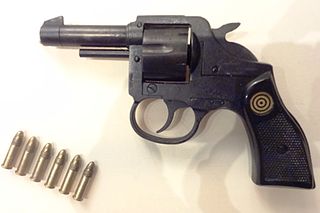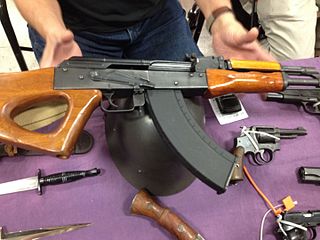
Gun control is the set of laws or policies that regulate the manufacture, sale, transfer, possession, modification, or use of firearms by civilians.

The Brady Handgun Violence Prevention Act, often referred to as the Brady Act or the Brady Bill, is an Act of the United States Congress that mandated federal background checks on firearm purchasers in the United States, and imposed a five-day waiting period on purchases, until the National Instant Criminal Background Check System (NICS) was implemented in 1998. The act was appended to the end of Section 922 of title 18, United States Code. The intention of the act was to prevent persons with previous serious convictions from purchasing firearms.

The National Advisory Commission on Civil Disorders, known as the Kerner Commission after its chair, Governor Otto Kerner Jr. of Illinois, was an 11-member Presidential Commission established by President Lyndon B. Johnson in Executive Order 11365 to investigate the causes of the long, hot summer of 1967 in the United States and to provide recommendations for the future.
Gun laws in Australia are predominantly within the jurisdiction of Australian states and territories, with the importation of guns regulated by the federal government. In the last two decades of the 20th century, following several high-profile killing sprees, the federal government coordinated more restrictive firearms legislation with all state governments. Gun laws were largely aligned in 1996 by the National Firearms Agreement. In two federally funded gun buybacks and voluntary surrenders and State Governments' gun amnesties before and after the Port Arthur Massacre were collected and destroyed, more than a million firearms, possibly 1/3 of the national stock.
Gun politics is an area of American politics defined by two primary opposing ideologies about civilian gun ownership. People who advocate for gun control support strengthening regulations related to gun ownership; people who advocate for gun rights support weakening regulations related to gun ownership. These groups often disagree on the interpretation of laws and court cases related to firearms as well as about the effects of firearms regulation on crime and public safety. It is estimated that U.S. civilians own 393 million firearms, and that 35% to 42% of the households in the country have at least one gun. The U.S. has the highest estimated number of guns per capita, at 120.5 guns for every 100 people.

Brady: United Against Gun Violence is an American nonprofit organization that advocates for gun control and against gun violence. It is named after James "Jim" Brady, who was permanently disabled as a result of the Ronald Reagan assassination attempt of 1981, and Sarah Brady, who was a leader within the organization from 1989 until 2012.

Saturday night special is a colloquial term in the United States and Canada for inexpensive, compact, small-caliber handguns made of poor quality metal. Some states define these junk guns by means of composition or material strength. In the late 19th century and early 20th century, they were commonly referred to as suicide specials.
The Violence Policy Center(VPC) is an American nonprofit organization that advocates for gun control.

Gun show loophole is a political term in the United States referring to the sale of firearms by private sellers, including those done at gun shows, that do not require a federal background check of the buyer. This is also called the private sale exemption.. Under federal law, any person may sell a firearm to a federally unlicensed resident of the state where he resides as long as he or she does not know or have reasonable cause to believe the person is prohibited from receiving or possessing firearms.
Proposition B in Missouri was a failed 1999 ballot measure that would have required local police authorities to issue concealed weapons permits to eligible citizens. It was a contentious issue and was narrowly rejected at the time by the electorate, but the legislature later approved similar legislation in 2003.

The Police Executive Research Forum (PERF) is a national membership organization of police executives primarily from the largest city, county and state law enforcement agencies in the United States. The organization is dedicated to improving policing and advancing professionalism through research and involvement in public policy debate. Since its founding in 1976 with support and funding from the Police Foundation, it has fostered debate, research and an openness to challenging traditional police practices. It is headquartered in Washington, D.C.

Gun violence in the United States results in tens of thousands of deaths and injuries annually. In 2018, the most recent year for which data are available as of 2021, the Centers for Disease Control and Prevention's (CDC's) National Center for Health Statistics reports 38,390 deaths by firearm, of which 24,432 were by suicide. The rate of firearm deaths per 100,000 people rose from 10.3 per 100,000 in 1999 to 12 per 100,000 in 2017, with 109 people dying per day or about 14,542 homicides in total, being 11.9 per 100,000 in 2018. In 2010, there were 19,392 firearm-related suicides, and 11,078 firearm-related homicides in the U.S. In 2010, 358 murders were reported involving a rifle while 6,009 were reported involving a handgun; another 1,939 were reported with an unspecified type of firearm.

Gun-related violence is violence committed with the use of a gun. Gun-related violence may or may not be considered criminal. Criminal violence includes homicide, assault with a deadly weapon, and suicide, or attempted suicide, depending on jurisdiction. Non-criminal violence includes accidental or unintentional injury and death. Also generally included in gun violence statistics are military or para-military activities.
Created in 1981, the Eisenhower Foundation is the private sector continuation of two Presidential Commissions – the 1967-1968 bipartisan National Advisory Commission on Civil Disorders and the 1968-1969 bipartisan National Commission on the Causes and Prevention of Violence.
The Millennium Breach was sponsored by the Eisenhower Foundation to mark the thirtieth anniversary of the Kerner Report on March 1, 1998. The Kerner Report was released by the Kerner Commission, a committee established by President Lyndon B. Johnson in 1968 to investigate the causes of the 1967 race riots in the United States and to provide recommendations for the future. The infamous passage of the Kerner Report found, "Our nation is moving toward two societies, one black, one white—-separate and unequal."
The State of Texas is considered to have some of the most relaxed gun laws in the United States. Public concerns over gun control in Texas have increased in recent years as Mexican drug cartels continue to commit violent crimes closer to Texas' stretch of the Mexico–United States border. They have also increased due to the number of incidents, including misuse of firearms stolen from other sources.

Proposals for universal background checks would require almost all firearms transactions in the United States to be recorded and go through the National Instant Criminal Background Check System (NICS), closing what is sometimes called the private sale exemption. Universal background checks are not required by U.S. federal law, but at least 22 states and the District of Columbia currently require background checks for at least some private sales of firearms.

The Trace is an American non-profit journalism outlet devoted to gun-related news in the United States established in 2015 with seed money from the largest gun control advocacy group Everytown for Gun Safety, which was founded by former New York City mayor Michael Bloomberg, and went live on 19 June of that year. The site's editorial director is James Burnett.
Locked in the Poorhouse is a 30-year update of the final report of the National Advisory Commission on Civil Disorders, co-authored by former Kerner Commissioner, Senator and Milton S. Eisenhower Foundation Chairman Fred R. Harris and Eisenhower Foundation President Alan Curtis. The book was released in 1998 with a companion volume, The Millennium Breach.

Alan Curtis, also known as Lynn Alan Curtis, is an American social scientist, public policy advisor, author and speaker who is the founding president and CEO of the Milton S. Eisenhower Foundation. The foundation was founded In 1981 the private sector continuation of the National Advisory Commission on Civil Disorders and the National Commission on the Causes and Prevention of Violence.












